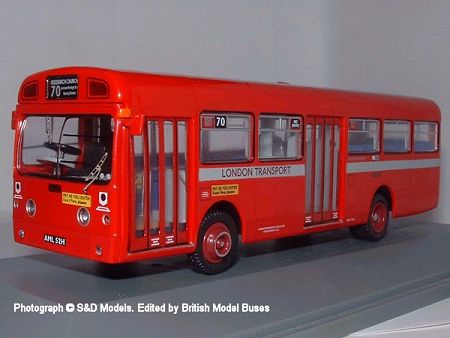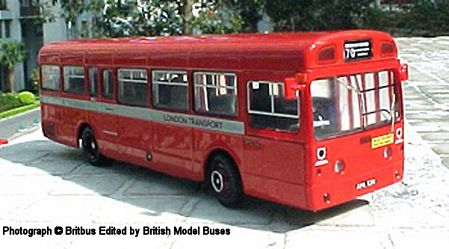|
Britbus
AS02 – AEC Swift London Transport
Review
by Mark Smith
Possibly
one of the most universally unloved buses of all time, the AEC Swift has
now been immortalised by Britbus in 1/76 scale.
This red liveried version was a must-have for my collection, simply
because I have been lucky enough to encounter the preserved example at the
Cobham Bus Museum on a couple of occasions.
The London Swift made in interesting comparison with the Ipswich
version, which is rather more familiar to me – I help look after Ipswich
82 at the Ipswich Transport Museum (and so I know what a job they are to
keep roadworthy!). Many of
the ‘Londonised’ features of the Swift, such as the driver’s dash,
AFC equipment and the distinctive LT body specification have been
splendidly recreated on this excellent model.
LT/LCBS
acquired 838 Swifts, with similarly styled Park Royal, MCW or Marshall
bodies. They were all
equipped with AEC AH505 8.2 litre engines, four speed fully automatic
gearboxes and power steering. The
majority were dual door buses, and many had automatic fare collection
equipment fitted. The Britbus
model, depicts a central area Park Royal bodied ‘standee’ version, SMS
52, in original condition, on route 70.
First
impressions are favourable. The
body shape is impeccable, with accurate colours.
The flake grey central band looks the perfect shade, and the red is
nice and bright. Separate
mirrors, etched wipers and offside engine grille are nice touches, and
separate lenses depict the head and fog lights.
The destination blinds are printed behind the blind box ‘glass’
with printed detail limited to the various signs, logos and external
loudspeaker grilles on the window vents beside the doors.
Without
recourse to drawings it is difficult to quantify the dimensional accuracy,
but scaling the casting reveals a model that is certainly there or
thereabouts. One or two
comments have suggested the model sits a bit high on it’s wheels, but I
suggest that this is more to do with the prominent lifeguards under the
body being missed off – there should be a separate horizontal member
fixed on brackets running under the body between the front and rear wheel
arches on both sides. This
omission is not immediately apparent, but rather surprising nevertheless.
Internally
the basic interior is enlivened by an accurate rendition of the automatic
fare collection equipment, complete with signs, turnstile and guard rail.
The model is easily disassembled for a grumpy 1970’s OMO driver
to be inserted along with some suitably chastised passengers!
The
wheels ‘pose’ and have passable representations of the AEC hubs and
nut guard rings. The rear
hubs have a silvered centre cap and are similarly acceptable.
In
conclusion then? Well,
superb. The gripes are very
minor – the front destination box looks slightly undersized, the
lifeguards are missing and the PAYE transfers are very slightly inaccurate
(the lettering should be centred). I’m
not sure the engine grille should be mesh, as slats were certainly the
norm on provincial Swifts. Photos
of London Swifts in my possession are inconclusive on this last point and
I may be wrong! Nevertheless
these points certainly do not detract from the effort Britbus have
obviously put into getting this model right.
Overall,
a first class effort, which looks the part and deserves many plaudits –
the future potential for sub-types (SM, SMD etc) and liveries is quite
varied, and the fact that the entire front panel including windscreen and
front dash suggests such variations may not be far off.
A Maltese one would be very nice.
Mind you, however quickly you say £27.99, it is still a rather
pricey model!
Review
© Mark Smith February 2005
|

